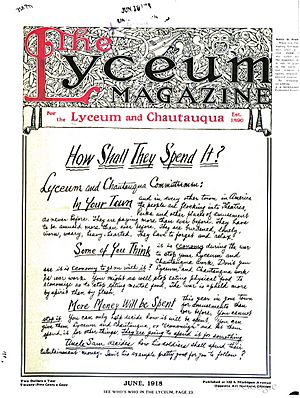Lyceum movement facts for kids

The lyceum movement in the United States was a group of organizations. They offered many public education programs and fun events. These groups were very popular in the mid-1800s. You could find them especially in the Northeast and Midwest parts of the country. Some of these organizations continued until the early 1900s.
Contents
What Was the Lyceum Movement For?
Lyceums, along with groups like mechanics’ institutes and farming organizations such as The Grange, were very important. They grew popular in the U.S. before and after the American Civil War. These groups helped a lot with adult education in America.
During this time, hundreds of informal groups started. Their goal was to make society better. They wanted to improve people's social lives, knowledge, and good behavior. The lyceum movement offered many activities. These included lectures, plays, classes, and debates. Famous speakers, entertainers, and readers would travel around. They went from town to town or state to state. This was called the "lyceum circuit." They never stayed in one place for too long. Their events were open to everyone. This helped educate many American adults in the 1800s.
How the Lyceum Movement Started
The very first American lyceum was founded in 1826. It was called "Millbury Branch Number 1 of the American Lyceum." Josiah Holbrook started it. Holbrook was a teacher who traveled and gave talks. He believed that learning should happen throughout your whole life. He wanted to create a big "National American Lyceum" organization. This group would oversee this way of teaching. Other educators liked the idea of lyceums. However, they were not interested in forming a large national organization. So, Holbrook's big plan was eventually dropped.
When the Lyceum Movement Was Most Popular
The Lyceum Movement was most popular before the American Civil War. This time is sometimes called the "antebellum era." Public lyceums were set up all over the country. They reached as far south as Florida. They also went west to Detroit, Michigan.
Important thinkers called Transcendentalists supported the movement. These included Ralph Waldo Emerson and Henry David Thoreau. They gave many speeches at local lyceums. Even Abraham Lincoln gave a speech to a lyceum. He did this when he was a young man in Springfield, Illinois.
Lyceums and Entertainment
After the American Civil War, lyceums started to change. They were used more often for traveling entertainers. These included vaudeville shows and minstrel shows. However, they were still used for public speeches and lectures. Many famous people spoke at lyceums in the late 1800s. These included Susan B. Anthony, Elizabeth Cady Stanton, Victoria Woodhull, Anna Dickinson, Mark Twain, and William Lloyd Garrison.

